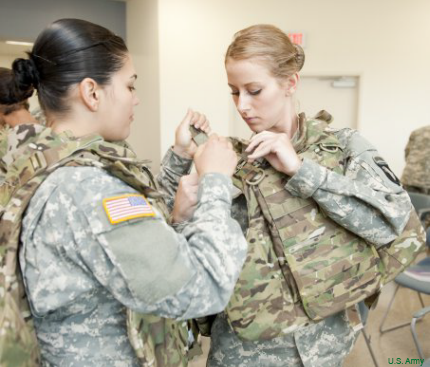3D body scans are a fit for Army clothing, equipment
A database of 3D data at Natick's research center helps make clothing, armor and other equipment that fit and function better.

Data from 3D body scans has helped improve the fit of female body armor.
Army scientists are using a database of 3D body scans to develop better-fitting clothing and more properly contoured equipment for soldiers.
The ANSUR II 3-D Shape Database at the Natick Soldier Research, Development and Engineering Center holds the Army’s most recent anthropometric survey data and 3-D whole body scans in a searchable platform that not only could help make clothing fit better but could make armor and other equipment more functional.
“We developed our own shape descriptor and query method for 3-D body scans," Dr. Peng Li, a computer scientist on NSRDEC's anthropology team, said in a release. "It will help determine different shapes for body armor and protection and gear for heads and faces."
The center’s last anthropometric survey was in 1988, so Natick set out to identify changes in the body size and shape of Army personnel, as well as to account for the growing number of women in the service. The survey—which included 3D scans of the head foot and whole body of 7,435 men and 3,922 women—did find that soldiers, in general, have gotten a little wider, but the 3D data, which wasn’t taken in the caliper-and-tape-measure days of 1988, presented new possibilities.
Li is working on ways to use that information to define common shapes to assist Army engineers, scientists and designers in developing better clothing and equipment, such as armor, shelters, kitchens, airplane cockpits and vehicle crew stations. "Peng has been working on tools to make the body scans more accessible and more usable," said Steve Paquette, a research anthropologist and team leader.
Data on women’s body dimensions proved particularly valuable, since the center didn’t have that much of it in 1988 and simply making smaller versions of equipment used by males doesn’t really work. With the 3D data and other measurements, the team has developed eight new sizes based on female anatomy.
"The ANSURII 3-D Shape Database is an integrated database that provides access to both traditional measurements and 3-D scans collected in ANSUR II survey," Li said. "It allows a user to search or query body dimensions and shapes, and to download search results in spreadsheet and 3-D surface files."
The data helps especially with items that require a snug fit, like armor, helmets and goggles, as well as with clothing. And the team also uses it to help product developers improve the human interfaces of equipment. "We work closely with human factors and biomechanics," Paquette said. "It's not just what size they are, but how the human interfaces with the environment or work station. Can they reach? Can they see? Anthropometry is just one piece of the whole picture."
"Comfort, performance, safety and fit - that's what it's all about," Paquette said. "If it doesn't fit right, you don't even want to wear it."



